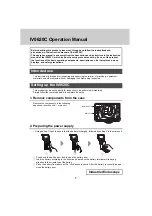
9
•
Do not insert the insertion tube into an observation object that is in operation or conducting electricity.
Otherwise the insertion tube may be damaged by being caught inside of the observation object, etc., or the
insertion tube may touch the object, resulting in electric shock.
•
Before stowing the instrument in its carrying case, be sure to turn off the power and attach the battery cap.
Leaving the battery loaded during storage can cause it to become hot, causing the risk of fire.
CAUTION
•
Do not use this instrument in any environment (including strongly radioactive environments) that does not
conform to the specified operating environment.
Otherwise, unexpected accidents that may damage the insertion tube may result.
•
Do not insert the insertion tube into an observation object in an environment that is outside the operating
temperature range.
Continued use may damage or reduce the performance of the instrument.
•
Do not touch the distal end immediately after use in a high-temperature environment.
Doing so may cause burn injuries.
•
Do not grip the control unit for a prolonged period of time when using the instrument in a high-temperature
environment.
Doing so may result in low-temperature burns. To prevent this, take precautions such as by wearing a pair
of gloves.
•
Pay attention not to trip over the power cord or cables of the insertion tube.
•
Use only a power cord and AC adapter specified by Olympus.
Doing so may result in fuming, fire, or electric shock.
•
Do not use the AC adapter outdoors.
Doing so may result in fuming, fire, or electric shock.
The AC adapter is designed for indoor use.
•
Do not subject the AC adapter to strong impact cause by striking it against a wall, dropping it, etc.
Otherwise, malfunction, damage, or electric shock might occur.
•
Do not use commercially-sold electronic transformers for overseas travel use (travel converters).
•
If abnormality is found during insertion of the insertion tube, do not push it in forcibly. Pull out the insertion
tube carefully.
Pay attention to the following when pulling out the insertion tube.
-
Do not bend it forcibly.
-
Do not pull out the inspected object when the angulation section is bent.
-
If the insertion tube gets caught inside while withdrawing, pull while turning it carefully.
•
Pay attention to the following when pulling out the insertion tube.
-
Do not hit or pull the distal end.
-
Do not squeeze or bend the angulation section with force.
-
Do not use the insertion tube if any of the parts are loose.
-
Attach the tip protection hood correctly for use.
If the protection hood is not firmly attached to the distal end of the insertion tube, the entire observation image or
a part of it may appear whitish due to the illumination, or a part of the angle of view may not be visible. Also, the
protection hood may fall off into the inspected object.
•
Do not look directly into the light emitted from the distal end.
Doing so may hurt your eyes.
Abnormal
The image appears white
(due to strong light on some
parts of the image)
Normal
The entire image
appears clear.






























